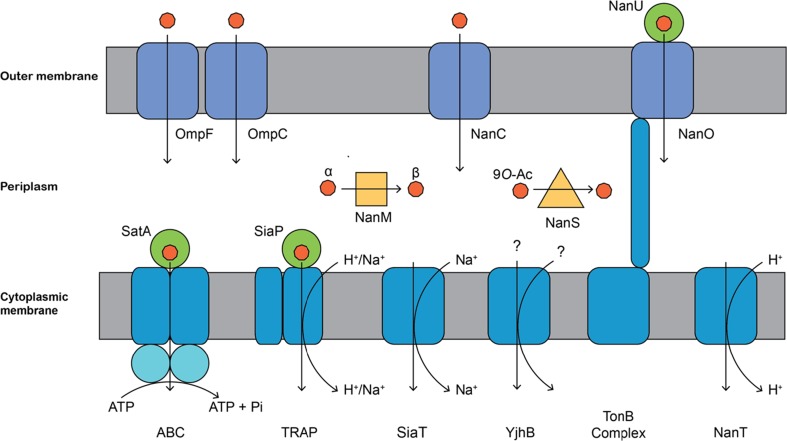Fig. 2.
Sialic acid transporter types. Within Gram-negative bacteria, sialic acid must first cross the outer cell membrane before it can be imported into the cell. This can occur by simple diffusion through the non-specific porins, OmpF and OmpC (grouped together). Specific channels, such as NanC, allow for the facilitated diffusion of sialic acid, whereas the NanOU system allows for the active transport of sialic acid. This is mediated by an extracellular uptake protein NanU, which binds sialic acid, the β-barrel NanO and the TonB complex, which energises the transport. Once in the periplasmic space, the processing enzymes NanM (yellow square) and NanS (yellow triangle) are known to mutarotate between the anomeric states of sialic acid and deacetylate the 9 position of 9-O-acetylated derivative, respectively. Some transporter systems require a periplasmic or cell surface-associated substrate binding protein (green circles) which interacts with the membrane component of the respective transporter. Finally, to traverse the inner membrane, bacterial pathogens have evolved multiple mechanisms of sialic acid transport which vary between species. ABC transporters are primary transporters that couple solute translocation with the hydrolysis of ATP by the ATPase domains. TRAP, NanT and SiaT transporters are secondary transporters that couple solute translocation with an electrochemical gradient. It is unclear whether TRAP sialic acid transporters are proton- or sodium ion-dependent, but NanT sialic acid transporters have been shown to be proton-dependent, while SiaT sialic acid transporters have been shown to be sodium ion-dependent. The stoichiometry of ions required for transport is not well understood. YjhB is a putative permease, which is similar in topology to NanT, although it lacks the central hydrophilic domain. While the other transporters are believed to transport N-acetylneuraminic acid, YjhB is suggested to transport less common derivatives. For simplicity, sialic acids are depicted as orange circles, while the membranes are in grey

